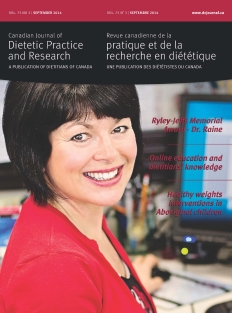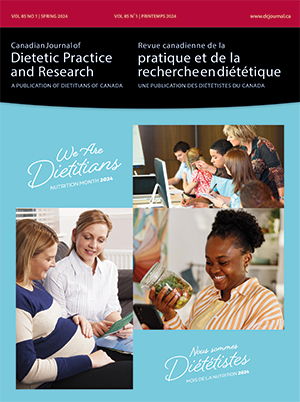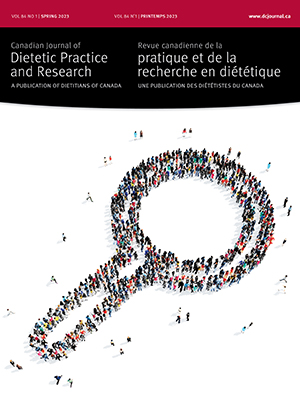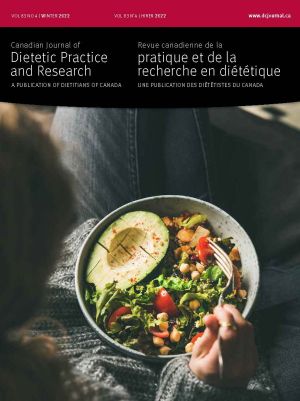Volume 75 • Number 03 • September 2014
Chair's Message
Editor's Message
Research
Purpose: To determine the attitudes and knowledge of Fraser Health registered dietitians (RDs) regarding recommending and ordering multivitamin/mineral supplements prior to and following an online education module. Methods: The educational intervention consisted of narrated slides with electronic resources. After undergoing external review for face and content validity, 6 attitude questions and a 15-item knowledge test were administered pre- and postintervention. The attitude questionnaire utilized a 5-point Likert scale and had a maximum summative score of 30 points. The knowledge test was worth a maximum of 15 points. Results: Of the eligible RDs (n = 123), 57 (46.3%) completed the study and 55 participants were included in the final analyses. Summative attitude scores were higher on the post-intervention questionnaire compared with the preintervention questionnaire (t = 92.5, P < 0.001). The proportion of correctly answered knowledge questions pre- (78.0% ± 10.0%) to postintervention (mean = 87.4% ± 6.0%) increased significantly (t = 7.16, P < 0.001). Conclusions: Postintervention, RD attitudes and knowledge improved confirming that the education strategy was effective. Future work should focus on optimizing the module and knowledge questions.
Purpose: The purpose of this study was to explore the implementation of the Ontario School Food and Beverage Policy (P/PM 150) from the perspective of secondary-school students. Methods: This research, informed by the ANGELO framework, undertook three focus groups with secondary students (n = 20) in 2 school boards representing both high- and low-income neighbourhoods in fall 2012. Focus groups were transcribed verbatim for subsequent analysis. Key themes were generated deductively from the research objectives and inductively as they emerged from transcripts. Results: Perceived impacts of P/PM 150 included high-priced policy-compliant food for sale, lower revenue generation, and food purchased off-campus. Limited designated eating spaces, proximity to external, nonpolicy-compliant food, and time constraints acted as key local level barriers to healthy eating. Conclusions: Pricing strategies are needed to ensure that all students have access to nutritious food, particularly in the context of vulnerable populations. Recognition of the context and culture in which school nutrition policies are being implemented is essential. Future research to explore the role of public health dietitians in school nutrition policy initiatives and how to leverage local resources and stakeholder support in low income, rural and remote populations is needed.
Review
There is evidence that Aboriginal children and youth in Canada and elsewhere are at higher risk of obesity and overweight than other children. However, there has been no review of healthy weights interventions specifically aimed at Aboriginal children. A structured search for peer-reviewed articles presenting and evaluating healthy weights interventions for Aboriginal children and youth was conducted. Seventeen articles, representing seven interventions, were reviewed to identify their main characteristics, evaluation design, and evaluation outcomes. Interventions included several large community-based programs as well as several more focused programs that all targeted First Nations or American Indians, rather than Métis or Inuit. Only 1 program served an urban Aboriginal population. None of the published evaluations reported significant reductions in obesity or overweight or sustained increases in physical activity, although some evaluations presented evidence of positive effects on children's diets or on nutrition knowledge or intentions. We conclude that broader structural factors affecting the health of Aboriginal children may limit the effectiveness of these interventions, and that more evidence is required regarding interventions for Aboriginal children in various geographic and cultural contexts in Canada including Inuit and Métis communities.
Perspectives in Practice
Metabolic syndrome (MetS) refers to a particular cluster of metabolic abnormalities (hypertension, dyslipidemia, type 2 diabetes, and visceral fat deposition) that can lead to a 1.5- to 2-fold increased relative risk of cardiovascular disease. Various combinations of healthier eating patterns and increased physical activity have been shown to improve metabolic abnormalities and reduce MetS prevalence. Dietitians who counsel MetS patients are challenged to integrate guidance from various medical management guidelines and research studies with effective behavioural change strategies and specific advice on what food and eating pattern changes will be most effective, feasible, and acceptable to clients. As part of a demonstration project that is currently underway, we developed a care map (decision aid) that represents the key decision processes involved in diet counselling for MetS. The care map is based on evidence from both clinical and health behaviour change studies and expert consensus and has undergone limited dietitian review. It is being used to help project dietitians clearly articulate their specific food intake change goals. Additional studies to directly compare counselling strategies could inform future development of the map. In the meantime, dietitians may find this care map helpful in clarifying counselling goals and strategies in this client group.
Video technology is a potentially effective means to teach individuals with developmental disabilities (DD) about healthy eating. Research in this area, however, is relatively unexplored. This study developed and tested a video intervention to teach healthy eating to adults with DD. A 5-segment educational video, an accompanying workbook, and a facilitator guide were developed to teach basic healthy eating concepts to adults with DD. Twelve adults with DD took part in a 5-week educational program led by trained facilitators using the materials created. Pre- and posttests were used to measure knowledge gained from participating in the intervention. Seventy-five percent (n = 9) of participants improved their knowledge scores, 8% (n = 1) maintained residue knowledge, and 17% (n = 2) had a decrease in their score. Video instructions can be an effective intervention modality to increase knowledge in adults with DD about healthy eating. Key enablers identified for participants’ knowledge gain included video content developed based on the learning need and cognitive level of intended users; program delivered by facilitators trained in effective teaching strategies; and engaging the participants’ staff, family, and caregivers to provide ongoing reinforcement about healthy eating.
Report
Purpose: Although puréed foods are commonly recommended for individuals with dysphagia and the acceptability of these foods is often a concern, few sensory studies on puréed foods have been carried out. The aim of this study was to evaluate the impact of serving style (i.e., scooped vs molded), on identification and acceptability of puréed foods in younger and older adults. Methods: Acceptability of scooped versus molded puréed meats and vegetables was evaluated using the hedonic general Labeled Magnitude Scale. The younger adult panelists (n = 97; 55 F, 42 M) were recruited from the University of Florida staff and students, and the older adult panelists (n = 70; 59 F, 11 M) were recruited from the community. Results: The younger panelists correctly identified a higher percentage of puréed foods than did the older panelists. Scooped puréed foods were more acceptable than molded. Conclusions: The results suggest that puréed foods may be more acceptable and identifiable when served without molding for both younger and older adults.
Purpose: To measure the prevalence of malnutrition, risk factors for poor dietary intake and body composition in patients with brain tumours admitted to hospital for surgical resection. Methods: In this study, 316 patients admitted for brain tumour resection to the Neurosurgical service at St. Michael's Hospital were screened. Assessment tools included the Subjective Global Assessment (SGA) for nutritional status and Bioelectrical Impedance Analysis (BIA) for body composition. All measurements were performed by one research dietitian. Information regarding medical history, symptomology, and tumour pathology was recorded. Results: One hundred and nine participants were recruited. Malnutrition was present in 17.6% of patients, of whom 94.7% were moderately malnourished (SGA-B) and 5.3% severely malnourished (SGA-C). Key symptoms contributing to malnutrition included weight loss, nausea, vomiting, dysphagia, headaches, and fatigue. Patients with malignant tumors were more likely to have weight loss and lower fat mass. Conclusions: This study demonstrated that patients admitted for brain tumour resection have a low prevalence of malnutrition compared with other cancer populations. Useful parameters for nutritional screening of inpatient admissions include weight loss >5% of usual weight, nausea, vomiting, dysphagia, and headaches.
Purpose: Effective workplace wellness programs, featuring supports for healthy eating and active lifestyle behaviours, have been found to reduce health risks and the associated economic burdens for individuals, organizations, and their communities. As part of a larger study, the purpose of this research was to engage volunteer participants from a university community to identify healthy eating and active lifestyle barriers and supports. Methods: An ethics-approved, action-research design with photo elicitation technique was used to engage employees and students. Data were analyzed using qualitative analysis software. Results: Participants identified barriers and both current and future supports for healthy eating and active lifestyle on campus. These were coded under the sub-themes of food environment, food and nutrition quality, physical environment, physical activity, fitness centre, and awareness/communication. Conclusion: Photo elicitation was determined to be an effective technique to engage participants. Despite many supports, members of the university community still found it difficult to follow healthy eating and active lifestyle behaviours; however, a number of practical future supports were identified. This study also provided valuable insight into the role that dietitians can play in the development of successful wellness programs.
Purpose: This study was conducted to determine the prevalence of malnutrition at a Canadian children's hospital based on medical records and to identify gaps in current practices and rates/reasons for dietitian consult. Methods: A retrospective chart audit of patients admitted during a winter season was completed. Patients with length of stay <4 days were excluded, as were those with fluid retention diseases. Outcome variables included anthropometrics, diet order, rates and reasons for dietitian consult, and biochemical data. Results: Of the 83 charts reviewed (mean ± SD age 7.3 ± 5.6 years of age), weights were recorded less frequently than recommended (45% of patients ≤2 years of age and 85% of patients >2 years of age met or exceeded recommendations). Twenty-nine (36%) patients were identified at potential increased nutrition risk for overweight, 10 (12%) for underweight, and 31 (38%) patients had nutrition-related chart notes. Only 23 patients (28%) received a dietitian consult and, of those, 21 had a nutrition related chart note. Consultation occurred an average 5.4 ± 4.96 days after admission. Conclusions: These data emphasize the need for development of standardized screening and assessment tools to better identify pediatric patients at risk for malnutrition and to improve access to optimal nutrition care.
Recognition
OPEN ACCESS
Improving the nutritional health of the public continues to be a major challenge. Our mission of advancing health through food and nutrition has become increasingly complex, particularly as food environments shape the availability, affordability, and social acceptability of food and nutrition “choices”. Promoting nutritional health requires that dietitians expand our knowledge in understanding the determinants of healthy eating and of social change strategies that advocates for and acts on improving food environments. While no single strategy can solve the challenges of public health nutrition, we can each identify unique strengths and opportunities. If we practice in complementary ways, using those strengths for collective action will make us stronger together toward social change supporting improved nutritional health of the public.
The Canadian Foundation for Dietetic Research
OPEN ACCESS
Welcome to the nation's capital, Ottawa, Ontario host city of the 2014 Dietitians of Canada Annual Conference. The submissions for this year's Canadian Foundation for Dietetic Research event reflected the very high level of scientific quality and diversity of topics associated with Dietetic research in Canada. Through the support of Dietitians of Canada and the Canadian Foundation for Dietetic Research, the 2014 event was an educational and inspiring exchange of research and experience-sharing initiatives to help motivate conference attendees. The topics highlighted from this year's abstracts include Dietetic Practice and Education, Community-based Nutrition Education, Nutrition Health and Education, Vulnerable Groups and their Nutritional Needs, Clinical Research and Patient Services and much, much more. The research and experience-sharing work will provide new insights which can be applied to your work. Each presenter provided an 11 minute oral presentation (8 minutes for presenting and 3 minutes for questions). This allowed for meaningful interaction between the presenters and those attending the sessions. This year there were oral research presentations on each day of the conference: I urge you to use these presentations as an impetus to start your own research projects or to engage in conversations with your colleagues. This Research Event would not be possible without the commitment and dedication of many people. On behalf of Dietitians of Canada and the Canadian Foundation for Dietetic Research, I would like to extend a special thank you to the 2014 Abstracts Review Committee who represented research, clinical nutrition, community nutrition, education, food services and academics: Jennifer Brown (Registered Dietitian, The Ottawa Hospital Weight Management Clinic and Bariatric Surgery Program), Josée Bertrand (Acting Chief of Dietetics, The Ottawa Hospital), Marketa Graham (Public Health Dietitian, Ottawa Public Health Unit), Mahsa Jessri (PhD Candidate, Faculty of Medicine, University of Toronto), Mary Elizabeth Davies (Coordinator/Professor, Food and Nutrition Management, School of Hospitality & Tourism, Algonquin College), Dr. Bénédicte Fontaine-Bisson (Assistant Professor, Nutrition Sciences Program, University of Ottawa). I would also like to thank all of our moderators who took the time during the conference to keep our research presentation sessions on time. A special thank you to Shilpa Mukund and Isla Horvath at the Canadian Foundation for Dietetic Research for their guidance, patience, and support throughout the review process. I enjoyed interacting with many of you at the oral research presentations where we showcased the talents, efforts and important findings from our dietetic colleagues across our country. Marcia Cooper, PhD, RD Chair, 2014 Abstracts Review Committee Health Canada










